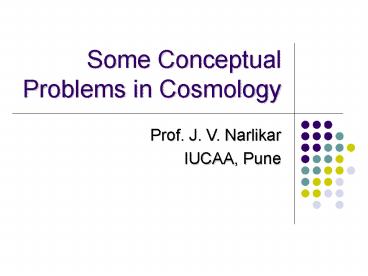Some Conceptual Problems in Cosmology - PowerPoint PPT Presentation
Title:
Some Conceptual Problems in Cosmology
Description:
Some Conceptual Problems in Cosmology Prof. J. V. Narlikar IUCAA, Pune – PowerPoint PPT presentation
Number of Views:78
Avg rating:3.0/5.0
Title: Some Conceptual Problems in Cosmology
1
Some Conceptual Problems in Cosmology
Prof. J. V. Narlikar IUCAA, Pune
2
- 1.
- Dark Matter and Dark Energy
Dark Matter
3
Why is dark matter needed?
To explain flat rotation curves
- mv2/r GM(r) m /r2 ? constant v implies M(r) ? r
- Since visible mass is confined to r lt rG , we
need dark matter beyond the visible radius rG . - The amount of dark matter may exceed the amount
of visible matter.
4
Why is dark matter needed?
To make up for potential energy in clusters
- If clusters are in dynamical equilibrium the
virial theorem applies - 2T ? 0.
5
Why is dark matter needed?
To make up for potential energy in clusters
- Observationally what is found is that the kinetic
energy is large compared to the potential energy.
The difference is made up by postulating dark
matter more or less at rest. - Again, the amount of dark matter exceeds that
actually observed in the form of galaxies, stars,
hot gas, etc.
6
How much dark matter is needed?
- Define closure density by
- ?C 3H2/ 8?G
- The matter density is denoted by ?m ?m ?C
- If we were limited to visible matter only, we
would have ?m ? 0.04 only. - The presence of dark matter means that the value
of density is greater than this.
7
The problem of deuterium
- If all the dark matter were baryonic, the
- observed abundance of deuterium cannot
- be explained by primordial nucleosynthesis.
- For primordial process to work we need the
- following inequality to hold
- ?m h02 ? 0.02.
- Hubbles constant is taken as 100 h0 km/s/Mpc.
8
The problem of deuterium
- Cluster / galaxy data suggests
- ?m h02 ? 0.15 h01.5 / (1 0.55 h01.5)
- Thus there is conflict with deuterium abundance
data.
9
The problem with inflation
- Inflationary cosmology predicts that the spatial
- part of the spacetime is flat, i.e., ?m 1.
- There is therefore a large gap between the
- density of matter (including dark matter) and
- the inflationary prediction.
10
The problem with structure formation
The problem with matter density so large as
required by inflation (whether dark or visible)
is that in forming large scale structures with
the observed level of inhomogeneity, it leaves
large signatures on CMBR.
11
Solution
- Make the following assumptions
- Dark matter is mostly non-baryonic.
- This helps in two ways
- it does not affect deuterium abundance and
- its signatures on CMBR are very minute.
- Assume that inflation occurred,
- i.e., ?m 1
- Assume that matter energy is mainly in these
two modes, ?m ?b?nb
12
- This view prevailed till the 1990s.
- Vide quote by Malcolm Longair in the 1986
Beijing IAU Symposium on Observational Cosmology - There is no evidence that ?? 0, and I find
the classical Friedmann models to have the great
appeals of simplicity and elegance - Beijing Conference Proceedings p.
828.
However, this did not turn out to be the last
word! The assumptions made above were not
sufficient. A new concept was necessary.
13
- Dark Energy
14
Dark Energy
- First introduced into GR by Einstein
- via the ?-term
- Rik - ½gik R ?gik - 8?G/c4 Tik .
- The extra term on the l.h.s. has a constant ? and
that is permitted by the covariance of the
equations. a variable ? will not do! - The advantage of this extra parameter is that it
enables more theoretical models within the
overall big bang scheme.
15
Dark Energy
- One can define
- a density parameter for ? , by
- ?? ?c2/3H02
- In a generalized framework this concept today is
called dark energy.
16
The age problem
- The age of the flat
- (k 0) Friedmann model is 2/3H0-1, which works
out at - ? 6.6 h0-1? 109 yrs.
This is too short a time span to accommodate old
galaxies. However, with ? , one gets models with
longer ages.
17
The density problem
- The flatness condition required too much by way
of density of nonbaryonic dark matter. Now we
can write - ?b ?nb ?? 1
- (0.04) (0.23) (0.73) .
- and pass on the lions share to ??.
18
The supernova problem
The models given by dark energy give a better fit
to the redshift-magnitude relation for Type 1a
Supernovae.
19
Some problems with non-baryonic dark matter and
dark energy
- As yet no candidate for NBDM has been found in
the terrestrial lab or in astronomy. - Even finding a possible supersymmetric particle
in the lab does not guarantee that it is a NBDM
candidate until one shows that it exists in the
cosmos with the right abundance.
20
Some problems with non-baryonic dark matter and
dark energy
- If dark matter is present in a cluster, why does
it not collapse towards the centre under its own
gravity? What keeps it in dynamical equilibrium. - For NBDM the normal pressure option is
not there. - Dark energy models today are highly speculative
and have no other direct support in any
astronomical observation.
21
Some problems with non-baryonic dark matter and
dark energy
- Dark energy models, except for the ? of Einstein
have no natural relationship to any existing and
established theoretical framework, like GUTs,
SUSY, etc.
22
- On aesthetic grounds
- one may question the propriety of placing
- faith in so much speculation based on so
- few direct observations.
- Is this physics ?
- or a new version of
- the Emperors New Clothes?
23
Emperor's New Clothes?































